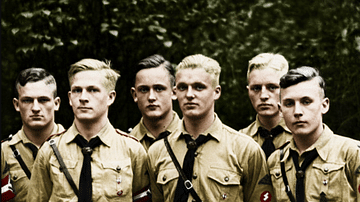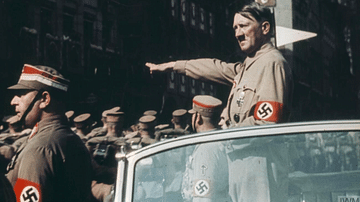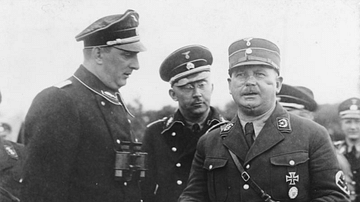
The Anschluss ('fusion') of 12 March 1938 was the annexation and formal union of Austria with Germany. Adolf Hitler (1889-1945), the Nazi leader of Germany, dreamed of an empire which enclosed all German speakers, his 'Greater Germany'. Hitler's military invasion met no resistance or meaningful response from foreign powers, and so Austria was absorbed into the Third Reich.
Many in Austria were sympathetic to the idea of joining Germany, but there were also those who knew their sovereignty would be lost for as long as Hitler was in power. Hitler was additionally attracted to occupying Austria since the Anschluss would give him access to new resources such as manpower for the military, raw materials, and a large quantity of cash and gold. The Austrian government was dissolved, and the very name Österreich (Austria's name in German) was banished from public use. The Nazis were not slow to begin imposing their ideology on Austrians and imprisoning those they identified as enemies. The union very swiftly became an occupation by a totalitarian regime.
A Weak League of Nations
Hitler had harboured ambitions to build a German empire or 'Greater Germany' ever since his book Mein Kampf (published in 1925), in which he described the need for Lebensraum (living space) for the German people – new lands where they could prosper. The Nazi party rose in popularity through the early 1930s, and Hitler was eventually invited to become chancellor in 1933. Quickly establishing a dictatorship through such measures as the Enabling Act, Hitler soon turned to an aggressive foreign policy that aimed to recover Germany's territorial losses following the Treaty of Versailles that had formally concluded the First World War (1914-18). Hitler had noted the lack of power of the League of Nations in the early 1930s. The League, formed after WWI with the goal of keeping world peace, had failed to act meaningfully to Japan's invasion of Chinese Manchuria in 1931.
Hitler gave world leaders mixed messages, insisting Germany should be allowed to rearm and break the restrictions of the Treaty of Versailles on its military capabilities but, at the same time, promising his commitment to world peace. The treaty specifically forbade the union of Germany and Austria. Hitler stated in 1934 that he had no intention of merging Austria into the Third Reich as his new German state was now called. Domestically, Hitler's policies were clearer. He had consistently promised the German people that he would reverse the points of the Treaty of Versailles – points which he felt were holding Germany back from achieving its full potential. The first practical step came with a plebiscite in the coal-rich Saar region, once part of western Germany but governed by the League of Nations since the end of WWI. In March 1935, the voters decided overwhelmingly to rejoin Germany. Hitler announced conscription in Germany in 1935 and began rearmament in earnest. The League of Nations was again shown to be impotent to acts of aggression when Italy invaded Abyssinia (Ethiopia) in 1935. No doubt, Hitler once again took note.

In March 1936, German armed forces occupied the Rhineland, an industrialised area between Germany and France which the Treaty of Versailles had stipulated should not have any military presence. The League offered no response to the reoccupation, which was, after all, only Germany 'taking control of its own back garden', a phrase coined by the British Times newspaper. Hitler had been prepared to withdraw his troops at the first sign of resistance, but the bluff had worked. In October 1936, the Spanish Civil War broke out, with both Italy and Germany directly involved and glad to test out their new military hardware. From July 1937, China was at war with Japan. In this background of international turmoil, Hitler felt the time was right to further expand the Third Reich by absorbing Austria, the country of his birth, into the growing state of Greater Germany.
Why Austria was Attractive to Hitler
The Anschluss, which translates as 'fusion', was, for the Nazis at least, an inevitable part of their plans for the domination of Europe, a plan which began by pulling all the German speakers into one state. Austria had been part of the Austro-Hungarian Empire ruled by the Habsburg dynasty, but this had been broken up after WWI. In the interwar years, Austria had a population of 6.7 million and covered 84,000 square kilometres (32,400 square miles). Austrians mostly spoke German, and there were many points of culture, politics, and history common to that of Germany.
Thanks to rearmament, Germany had achieved near-full employment by 1938. Hitler had fulfilled his promise to the German people, but Germany's new war machine came at a cost. Rearming necessitated huge imports of raw materials, and these could not be bought for much longer as Germany's balance of payments was soon to go into the negative. Occupying territories where these resources could be found seemed a simple solution to the problem. Crucially, Germany had an arms advantage over its enemies, but this situation would not last long. A union with Austria would immediately give Hitler access to raw materials, increase Germany's overall energy and industrial production, and tap into a huge reserve of potential soldiers. In addition, possession of Austria would improve Germany's strategic defences in Europe and allow a much easier invasion of other neighbours, particularly in the Balkans and Czechoslovakia. Naturally, there were many in Austria who wished to preserve their independence, but Hitler was determined to use force, if necessary, to push through his plan of unification.

The Failed Coup
The 1938 Anschluss was actually Hitler's second attempt to unify Germany and Austria. Four years before, he had tried and failed to grab his southern neighbour. When Hitler had gained power in 1933 and then established himself as a dictator, sympathetic Austrian Nazis began to plan for a coup d'etat in Austria in February 1934. In the spring of 1934, pro-Nazis were tasked with causing trouble for the Austrian regime by blowing up train lines and government buildings, and attacking government officials. Weapons and explosives were supplied by Germany. Austria had been beset by a long line of weak coalition governments as no single party was able to dominate the political stage. Underground groups like the German Brotherhood worked for unification with Germany and were appalled at the growing dominance of the increasingly autocratic chancellor Engelbert Dollfuss (1892-1934). Dollfuss was pro-Italy and anti-Germany in his politics; he banned the Nazi party (and any other party besides his own) in Austria in June 1934. On 25 July, Dollfuss was gravely wounded in a Nazi attack in his office. The attackers were members of a special branch of German-organized SS stormtroopers dressed in Austrian army and police uniforms. Dollfuss died a few hours later having bled to death because his attackers refused to allow him medical treatment. This political assassination became known as the Dollfuss Affair.
In August, a new Chancellor of Austria was appointed, Kurt von Schuschnigg (1897-1977). It was Schuschnigg, with the backing of the Austrian military, who had ensured the German-backed putsch (takeover) had failed. The fascist dictator of Italy, Benito Mussolini (1883-1945), also contributed to the coup's failure. Mussolini had his own ambitions for Austrian territory and did not support Germany's plans for a takeover. After the assassination of Dollfuss, Mussolini moved four divisions of Italian troops to the Italy-Austria border, ready to honour a treaty between the two states that called for mutual protection if one was the victim of outside aggression. Dollfuss had particularly cultivated relations with Mussolini and even drawn up a new fascist constitution in 1934, but the chancellor had at the same time gained enemies for his authoritarian approach to government. Then the governments of Italy and France made a joint declaration that they supported Austrian independence. The last straw was the fact that Dollfuss' wife and children were guests of Mussolini when the chancellor had been shot. 13 of the putsch ringleaders were caught and hanged. Hitler decided to distance himself from these unsavoury events and to prudently wait for a better opportunity to take over Austria. Hitler publicly declared on 21 March 1935 that "Germany neither intends nor wishes to interfere in the internal affairs of Austria or to conclude an Anschluss" (Shirer, 296). The same month, Hitler formally repudiated the Treaty of Versailles. Foreign powers did not quite know what to make of Germany's foreign policy, if indeed it had a coherent one at all. Many leaders and diplomats, eager to avoid the horrors of another world war, were prepared to give Hitler the benefit of the doubt and listen only to his more peaceful overtures.
The Second Attempt at a Coup
Back in Austria, Schuschnigg tried to ward off Hitler's unwanted attentions over the next couple of years by giving Germany certain concessions, although he also introduced compulsory military service in April 1936. The German-Austrian agreement of 11 July 1936 promised that Austria would remain independent, but the country must follow a foreign policy that was in line with Hitler's, and (more secretly) all Nazi political prisoners must be given an amnesty. Then in October, Hitler pulled away from Austria the crucial support of Mussolini. Germany and Italy became formal allies with the Rome-Berlin Axis. In November 1936, Italy and Germany (and later Japan) signed the Anti-Comintern Pact, a treaty of mutual cooperation in empire-building and a united front against communism. According to Albert Speer (1905-1981), Hitler's chief architect and future armaments minister, "For years to come he [Hitler] would recall how magnanimously Mussolini had given his consent to the invasion of Austria. He would remain eternally grateful to the Duce for that, Hitler said" (Speer, 167).

Hitler met Schuschnigg in person in Germany on 12 February 1938 and now insisted that Nazis be permitted to hold positions of power in the Austrian government. Hitler warned Schuschnigg that the international community would not side with Austria in the case of a German invasion. Schuschnigg, still hoping a policy of appeasement might maintain Austria's independence, agreed in February 1938 to appoint the Austrian Nazi Arthur von Seyss-Inquart (1892-1946) as the minister of the interior, which meant he was effectively in charge of state security. Schuschnigg was also to appoint the pro-Nazi Edmund Glaise-Horstenau (1882-1946) as minister of war.
Schuschnigg tried to strengthen his government and position with Hitler by calling a referendum on the idea of the Anschluss with Germany. The vote was planned for 13 March 1938. Schuschnigg announced the referendum on 9 March. Hitler, shocked at this development and worried that the plebiscite would reveal a no vote to a union, had to act fast. As he had in 1934, Hitler first ordered Austrian Nazis to create as much trouble as possible for the Schuschnigg government. The idea was to create such civil unrest that Germany could justify an occupation of Austria as the only way order and public safety could be guaranteed. The German army, in Operation Otto, was then partially mobilised, and troops entered Austria on 12 March, the pretext being a fictitious telegram from a local official calling for urgent help to restore public order. The German forces crossed the border above Linz and moved eastwards to Vienna. The Austrian government, realising it could not win an armed contest (Austria had neither modern tanks nor planes) and wary that a sizeable portion of the population was, in any case, in favour of unification, capitulated. Radio broadcasts urged Austrians not to resist the invasion.
Pro-Nazis ensured that Hitler was given a welcome of cheering crowds when he toured Linz on the afternoon of 12 March, a scene repeated in Vienna on 14 March. Some historians have suggested that Hitler was surprised by the positive crowds and this made him determined to fully absorb Austria into a Greater Germany rather than settle for a mere Nazi puppet government. However, secret orders to the German generals may indicate Hitler planned a full occupation all along, perhaps from Schuschnigg's announcement of a plebiscite or quite possibly even earlier. Certainly, he had repeatedly threatened Schuschnigg with Germany's military capabilities. Whatever the real plans, Hitler, and not for the first time, had combined preparation with spontaneous decision-making in reaction to the moves of his enemies. And once again, largely using bluff and without significant violence, the Nazi dictator had acquired a vast new slice of territory.

From Union to Occupation
Although welcomed by half of the Austrian population (since Germany was prosperous and Hitler seemed to be going places), the Anschluss became a terrible reality for many. Schuschnigg was obliged to resign. Seyss-Inquart, who had briefly been chancellor in the few days before the Anschluss, now took over the role of president from Wilhelm Miklas (1872-1956). The unification of Germany and Austria became enshrined in a law passed on 13 March. Internally, Austria was reorganised along German lines with Nazi regional governors or Gauleiters. Seyss-Inquart added to his titles by becoming Reich governor of Austria and head of what was now a provincial government within the Reich. Austria sent 73 representatives to the German parliament in Berlin. Josef Bürckel (1895-1944), as 'Reich Commissioner for the reunification of Austria and the German Reich', was in charge of overseeing the details of the Anschluss.
Ultimately, 100,000 German troops were stationed in Austria. From 14 March, Austrian armed forces members had to swear an oath of allegiance to Hitler. Eventually, the Austrian army was assimilated into the German army. On 17 March, Austrian civil servants also had to swear an oath of loyalty to Hitler. Those Austrians who were against the union had no means to protest other than to leave, which tens of thousands did. With the German army came more sinister Nazi elements such as the Gestapo (secret police) and the SS paramilitary group who repressed resistance groups (although not always successfully). Those found guilty of expressing anti-Nazi sentiments were arrested and sent to concentration camps in Germany. Soon Austria had its own concentration camp, located at Mauthausen near Linz. Deportations involved as many as 70,000 Austrians. As in other places, the Nazis were keen to achieve a veneer of popular endorsement. In a rigged plebiscite in Austria on 10 April, 99.08% of the voters endorsed the Anschluss (a similar figure was produced in a German plebiscite). In short, Austria was no more.
Bürckel, as Hitler's personal representative, had absolute power in Austria, now called Ostmark (meaning 'Eastern Borderland'). The old name Österreich was banished from public use. Ostmark, like Germany, was now part of a totalitarian regime, with Hitler as its indisputable head. Meanwhile, lesser Nazis were already busy emptying Austrian banks of their foreign currency reserves. The Austrian Federal Bank's reserve of 1,368 million Reichsmarks was gratefully poured into the relatively empty coffers of the German Reich Bank, which then had a mere 76 million Reichsmarks. Austrian raw materials like iron ore, oil, and magnesite were transported to factories in Germany. The next phase of the occupation was the dissemination of Nazi propaganda and the rounding up of those people identified as enemies of the Reich, notably the Jews (as loosely identified by the 1935 Nuremberg Laws). Jews were strongly encouraged to leave – the wealthy had their assets confiscated, a policy which paid for the tickets of those who could not afford them. By the end of 1939, 60% of the (at least) 150,000 Jewish people in Austria before the Anschluss had left the country. Those who remained faced the increasingly violent methods the Nazis employed to eliminate Jews and other 'undesirables' from the Reich, methods which culminated in the 'Final Solution', the Holocaust where millions were killed in death camps.

Aftermath
The reaction of the world powers to the Anschluss was muted, most governments preferring to voice no more than a dissatisfaction with Hitler's methods while recognising the overwhelming popularity of the move as indicated by the plebiscites. Meanwhile, Hitler marched on into other parts of Europe. In the Munich Agreement of September 1938, Germany was permitted to keep the Sudetenland, the industrialised region of Czechoslovakia Hitler wished to occupy – the excuse being a German minority there was being repressed. The Munich Agreement was signed between Germany, France, Italy, and Britain, and it accepted Germany's new, expanded borders. Peace was not to last. In March 1939, German soldiers marched into the rest of Czechoslovakia. In April, Mussolini occupied Albania. In August, Germany and the USSR signed a military alliance, the Molotov-Ribbentrop Pact (Nazi-Soviet Pact). Then, at last, Hitler's invasion of Poland in September 1939 brought a formal declaration of war from Britain and France. 18 months after unification, Austrians found themselves involved in a world war that many considered against their own interests.
Schuschnigg, who had been imprisoned and moved to a Nazi concentration camp, survived until his release by the Allies at the close of the Second World War (1939-45). Seyss-Inquart, who had become Nazi governor of the occupied Netherlands, was tried at the post-war Nuremberg Trials, found guilty of crimes against humanity and hanged. Bürckel died of natural causes in 1944. Hitler committed suicide in his Berlin bunker in April 1945. In 1943, the Allies formally recognised Austria as being the first victim nation of Hitler's empire-building. Accordingly, after the Allied victory in the war in 1945, Austria was removed from the defunct Reich, and its sovereignty was restored.





